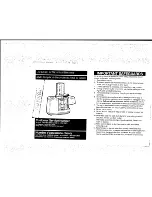
Signal/Connection Descriptions
Serial Host Interface
MOTOROLA
DSP56367
2-13
2.8
SERIAL HOST INTERFACE
The SHI has five I/O signals that can be configured to allow the SHI to operate in either SPI or
I
2
C mode.
Table 2-10 Serial Host Interface Signals
Signal
Name
Signal Type
State
during
Reset
Signal Description
SCK
Input or
output
Tri-stated
SPI Serial Clock—The SCK signal is an output when the SPI is configured as a master and
a Schmitt-trigger input when the SPI is configured as a slave. When the SPI is configured as
a master, the SCK signal is derived from the internal SHI clock generator. When the SPI is
configured as a slave, the SCK signal is an input, and the clock signal from the external
master synchronizes the data transfer. The SCK signal is ignored by the SPI if it is defined as
a slave and the slave select (SS) signal is not asserted. In both the master and slave SPI
devices, data is shifted on one edge of the SCK signal and is sampled on the opposite edge
where data is stable. Edge polarity is determined by the SPI transfer protocol.
SCL
Input or
output
I
2
C Serial Clock—SCL carries the clock for I
2
C bus transactions in the I
2
C mode. SCL is a
Schmitt-trigger input when configured as a slave and an open-drain output when configured
as a master. SCL should be connected to V
CC
through a pull-up resistor.
This signal is tri-stated during hardware, software, and individual reset. Thus, there is no
need for an external pull-up in this state.
This input is 3.3V tolerant.
MISO
Input or
output
Tri-stated
SPI Master-In-Slave-Out—When the SPI is configured as a master, MISO is the master
data input line. The MISO signal is used in conjunction with the MOSI signal for
transmitting and receiving serial data. This signal is a Schmitt-trigger input when configured
for the SPI Master mode, an output when configured for the SPI Slave mode, and tri-stated if
configured for the SPI Slave mode when SS is deasserted. An external pull-up resistor is not
required for SPI operation.
SDA
Input or
open-drain
output
I
2
C Data and Acknowledge—In I
2
C mode, SDA is a Schmitt-trigger input when receiving
and an open-drain output when transmitting. SDA should be connected to V
CC
through a
pull-up resistor. SDA carries the data for I
2
C transactions. The data in SDA must be stable
during the high period of SCL. The data in SDA is only allowed to change when SCL is low.
When the bus is free, SDA is high. The SDA line is only allowed to change during the time
SCL is high in the case of start and stop events. A high-to-low transition of the SDA line
while SCL is high is a unique situation, and is defined as the start event. A low-to-high
transition of SDA while SCL is high is a unique situation defined as the stop event.
This signal is tri-stated during hardware, software, and individual reset. Thus, there is no
need for an external pull-up in this state.
This input is 3.3V tolerant.
Summary of Contents for DSP56367
Page 16: ...xvi MOTOROLA CONTENTS Paragraph Number Title Page Number ...
Page 22: ...xxii MOTOROLA List of Figures Figure Number Title Page Number ...
Page 26: ...xxvi MOTOROLA List of Tables Table Number Title Page Number ...
Page 148: ...4 6 DSP56367 MOTOROLA Design Considerations PLL Performance Issues ...
Page 248: ...9 30 DSP56367 MOTOROLA Serial Host Interface SHI Programming Considerations ...
Page 306: ...10 58 DSP56367 MOTOROLA Enhanced Serial Audio Interface ESAI ESAI Initialization Examples ...
Page 389: ...Bootstrap ROM Contents MOTOROLA DSP56367 A 15 end ...
Page 390: ...A 16 DSP56367 MOTOROLA Bootstrap ROM Contents ...
Page 432: ...C 8 DSP56367 MOTOROLA JTAG BSDL ...
Page 484: ...D 52 DSP56367 MOTOROLA Programmer s Reference ...
Page 490: ...E 6 DSP56367 MOTOROLA Power Consumption Benchmark ...
Page 516: ...F 26 DSP56367 MOTOROLA IBIS Model ...
Page 522: ...Index 6 MOTOROLA Index ...
Page 523: ......
















































